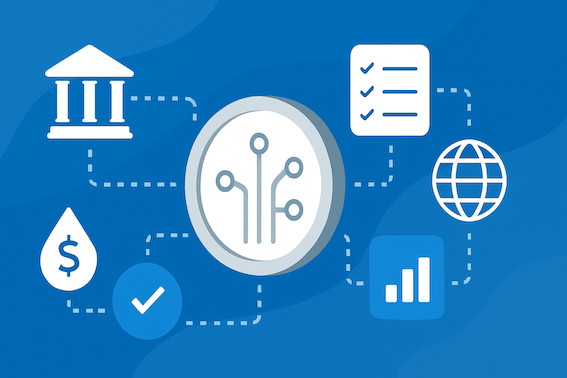A Quick Guide to Tokenized T-Bills and Their Benefits
The world of finance is constantly evolving, and traditional instruments are getting a modern makeover. Enter tokenized T-bills, a new twist on the classic short-term U.S. government debt.
Recently, the total value of tokenized U.S. Treasuries on public blockchains reached $1 billion, with BlackRock's BUILD surging 400% in a week from $40 million to $240 million, becoming the second-largest fund behind Franklin Templeton's Franklin OnChain U.S. Government Money Fund, represented by the BENJI token, with $360.2 million. Ondo Finance emerged as the largest holder of BUILD, owning 38% of its total supply. This milestone reflects the growing demand for tokenized Treasuries, driven by the significant increase in Treasury yields from 1.69% to 4.22% since March 2022, and offers crypto investors a diversified portfolio and flexible settlement options.

This remarkable growth piques our interest, making us eager to delve deeper into what U.S. Treasuries and tokenized T-Bills are all about. So, here we go.
What are T-bills?
Treasury bills (T-bills) are short-term U.S. government debt instruments. Essentially, you lend the government money for a fixed period (usually a few weeks to a year) at a discount. When the T-bill matures, you get your money back in full, along with the interest earned. Traditionally, T-bills are traded and held through specific channels.
A Short History of T-Bills: From Fixed-Price Subscriptions to a Digital Future
Treasury bills, or T-bills, are a cornerstone of the U.S. government's short-term borrowing strategy. But their journey to becoming the widely used financial tool they are today is an interesting one.
Early Days: Fixed-Price Offerings (Pre-1929)
The story of T-bills starts much like many government issuances – with a fixed-price subscription system. Investors would simply submit bids for a set price, and the government would accept or reject them. This approach, however, lacked flexibility and didn't always ensure the government received the best rates.
The Birth of T-Bill Auctions (1929)
A turning point came in 1929 with the introduction of T-bill auctions. This new system allowed investors to submit competitive bids, ensuring the government could borrow at the lowest possible interest rate. Initially, only 13-week bills were offered on a regular basis.
Evolution Through the Decades
Over the following decades, the T-bill market continued to evolve. By 1930, auctions were held quarterly to limit borrowing and reduce interest costs. The success of these auctions eventually led to the phasing out of certificates of indebtedness by 1934. By the end of that year, T-bills became the sole instrument for the government's short-term financing needs.
The Landscape Today
Today, T-bills are issued in a variety of maturities, ranging from 4 weeks to 1 year. They are a popular investment choice for individuals, institutions, and money market funds seeking a safe and secure way to park their money for short periods.
Characteristics of T-Bills
T-Bills are characterized by their zero-coupon nature. This means they do not pay periodic interest. Instead, they are issued at a discount to their face (par) value, and investors profit from the difference between the purchase price and the amount they receive at maturity. Maturity periods for T-Bills typically range from a few days to a maximum of one year, making them an ideal short-term investment vehicle. The most common maturities are one month, three months, six months, and sometimes twelve months. Because they are backed by the full faith and credit of the issuing government, T-Bills are considered virtually risk-free.
The Role of T-Bills in the Economy
T-Bills play a crucial role in both governmental finance and the broader economy. For governments, T-Bills are a flexible tool to fund short-term liquidity needs without the need to raise taxes or make immediate cuts to spending. This can be particularly important in times of economic stress or when unexpected expenses arise.
For investors, T-Bills offer a safe investment option with a predictable return, making them a cornerstone of money market funds and a popular choice for managing cash reserves. They are particularly appealing to risk-averse investors, such as banks, insurance companies, and pension funds, who value the combination of liquidity and security. Additionally, the rates on T-Bills serve as a benchmark for short-term interest rates in the economy, influencing other interest rates, including savings, mortgages, and loans.
Buying and Selling T-Bills
The primary method for purchasing T-Bills is through auctions conducted by the government's treasury department. These auctions determine the discount rate or yield of the T-Bills and are typically divided into competitive and non-competitive bids. Competitive bidders specify the yield they are willing to accept, and if too high, they risk not obtaining any T-Bills. Non-competitive bidders agree to accept whatever yield is determined at auction, ensuring that they will receive the T-Bills but not influencing the rate.
After the initial auction, T-Bills can be bought and sold on the secondary market, allowing investors to liquidate their holdings before maturity if needed. This market adds liquidity to T-Bills, making them even more attractive to investors who may need access to their funds before the T-Bill matures. Direct purchases from the government are also possible for investors who wish to hold the T-Bills to maturity, offering a straightforward way to invest in short-term government securities.
In summary, T-Bills are a fundamental component of government finance and the investment landscape, offering a risk-free option for short-term investment needs. Their role in the economy is multifaceted, affecting everything from government financing to the investment strategies of individuals and institutions.
Tokenizing Treasury Bills (T-Bills)
The advent of blockchain technology has introduced a transformative approach to traditional financial instruments, including Treasury Bills (T-Bills). Tokenization of T-Bills represents a pioneering shift in how government securities are traded and managed, offering a bridge between the traditional financial world and the burgeoning domain of digital assets.
Concept of Tokenized T-Bills
Tokenized T-Bills are digital representations of traditional T-Bills on a blockchain. Each token represents ownership or a claim to the underlying T-Bill, with the rights and obligations encoded within smart contracts. This digital format harnesses the benefits of blockchain technology, such as immutability, transparency, and security, to facilitate the issuance, trading, and settlement of government securities.
Benefits of Tokenized T-Bills
The tokenization of T-Bills introduces several advantages over their traditional counterparts:
- Increased Market Accessibility: Tokenized T-Bills can be fractionalized into smaller denominations, lowering the barrier to entry for individual investors and enabling a wider audience to invest in government securities.
- Enhanced Liquidity: The ability to trade tokenized T-Bills on digital asset exchanges around the clock not only increases liquidity but also allows for more dynamic pricing based on real-time market demand.
- Streamlined Processes: The use of smart contracts automates many of the processes involved in the issuance, trading, and settlement of T-Bills, reducing the need for intermediaries and making transactions faster and more cost-effective.
- Improved Transparency and Security: Blockchain's ledger ensures that all transactions are recorded transparently and securely, reducing the risk of fraud and error, while providing a real-time view of ownership and transactions.
Tokenization Process for T-Bills
The process of converting traditional T-Bills into tokenized form involves several steps:
- Legal and Regulatory Compliance: Ensuring that the tokenization of T-Bills adheres to local and international financial regulations is paramount. This includes establishing a legal framework that recognizes digital tokens as legitimate representations of government debt.
- Asset Selection and Digital Representation: T-Bills selected for tokenization are digitally represented on a blockchain. Each tokenized T-Bill is backed by an actual T-Bill, ensuring its value and authenticity.
- Smart Contract Development: Smart contracts are programmed to encode the terms and conditions of the T-Bills, such as maturity dates and the process for redemption at face value. These contracts automate various aspects of the T-Bills' lifecycle.
- Issuance and Trading on Blockchain Platforms: Once tokenized, T-Bills are issued on a blockchain platform, where they can be traded. These platforms facilitate the buying and selling of tokenized T-Bills, providing investors with easy access to the securities.
- Settlement and Redemption: The blockchain platform and smart contracts facilitate the seamless settlement of trades and the redemption of tokenized T-Bills upon maturity. This process ensures investors receive the face value of the T-Bills in a digital or fiat currency, as stipulated in the smart contract.
Zoniqx: Facilitating the Tokenization of Treasury Bills (T-Bills)
Zoniqx stands at the forefront of digital asset innovation, offering a sophisticated platform where traditional assets, like Treasury Bills (T-Bills), can transition into the digital realm. As a leading Tokenization Platform as a Service (TPaaS), Zoniqx leverages its unique Tokenized Asset Lifecycle Management (TALM) solution to redefine how assets are managed, traded, and secured in the blockchain space. Here's how Zoniqx can play a pivotal role in the tokenization of T-Bills, transforming them into accessible and efficient digital assets.
Secure and Swift Deployment of Tokenized T-Bills
Zoniqx's platform is engineered for the rapid deployment of digital assets, making it an ideal solution for tokenizing T-Bills. Utilizing the DyCIST (ERC-7518) standard, Zoniqx ensures that tokenized T-Bills are not only swiftly introduced into the market but are also anchored securely to Real World Assets (RWA). This approach guarantees that each digital token representing a T-Bill is backed by the actual government security, maintaining the integrity and value of the investment.
Enhanced Asset Lifecycle Management
With its proprietary Tokenized Asset Lifecycle Management (TALM) solution, Zoniqx offers a comprehensive suite of tools designed to manage the entire lifecycle of tokenized T-Bills. From issuance and trading to settlement and redemption, Zoniqx ensures that each phase is conducted transparently, efficiently, and securely. This lifecycle management solution simplifies complex processes, making it easier for governments to issue T-Bills and for investors to trade and manage their holdings.
Adoption of the Gold Standard DyCIST (ERC-7518)
The adoption of DyCIST (ERC-7518) positions Zoniqx as a pioneer in the tokenization space, setting a new standard for security and interoperability in digital assets. This protocol enhances the tokenization process by ensuring that digital tokens are not only securely linked to their underlying assets but also compatible across various blockchain platforms. This interoperability is crucial for the widespread adoption and liquidity of tokenized T-Bills, as it allows them to be traded on multiple exchanges and platforms without barriers.
Streamlining Regulatory Compliance
Navigating the regulatory landscape of digital assets can be challenging for issuers and investors alike. Zoniqx's platform is designed with compliance at its core, offering tools and protocols that align with current regulatory standards for tokenized assets. By streamlining compliance processes, Zoniqx mitigates the risks associated with regulatory breaches, ensuring that tokenized T-Bills are issued, traded, and managed in accordance with legal requirements.
Facilitating Global Access and Liquidity
Zoniqx (Formerly Tassets) not only democratizes access to tokenized T-Bills by making them available to a broader range of investors but also enhances their liquidity. Through its global platform, investors from around the world can trade tokenized T-Bills seamlessly, fostering a vibrant and liquid market. This global access is instrumental in expanding the investor base for T-Bills, potentially increasing demand and value for these tokenized government securities.
In summary, Zoniqx offers a revolutionary approach to the tokenization of Treasury Bills, combining security, efficiency, and compliance in a single platform. By leveraging Zoniqx's TALM (Tokenization Asset Lifecycle Management) solution powered by DyCIST - The Interoperable Protocol for Permissioned Tokens, the digital future of T-Bills is not only envisioned but actively realized, paving the way for a new era where traditional financial instruments and digital assets coexist and thrive in a secure and interoperable ecosystem.
To explore the capabilities of Zoniqx and see firsthand how it can transform traditional assets into tokenized digital assets, accessing the Zoniqx sandbox is your next step. The sandbox environment offers a hands-on experience with Zoniqx's platform, allowing you to test and understand its powerful features without affecting live operations.
For access to the Zoniqx sandbox and to learn more about how Zoniqx can assist in your tokenization journey, please email marketing@zoniqx.com.


.jpg)
